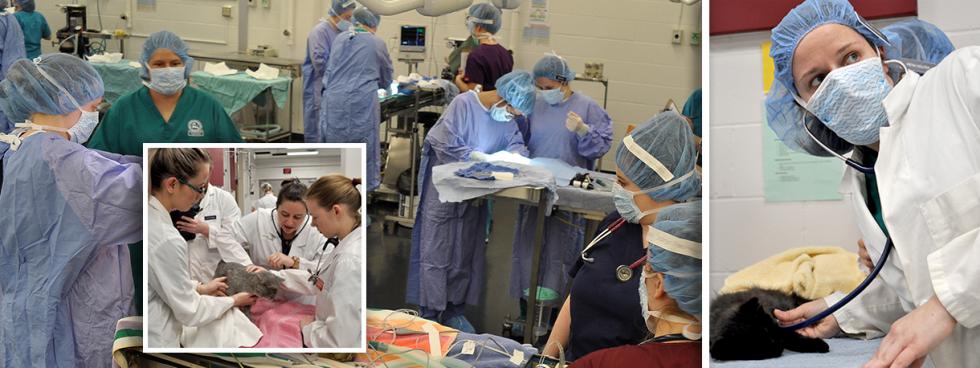
Practice Makes Perfect
There’s a first time for everything. And it can be a little nerve racking if that first time is a surgical procedure on a live animal.
That was the case for Meredith Behr, a second year veterinary medicine student.
“While I have observed a couple of dog spays and neuters, I haven’t had the opportunity to be involved in a cat neuter,” she said.
Behr got that opportunity earlier this semester as part of the “Principles of Surgery” class which all second year veterinary students take in during the spring semester. As part of the class, the students are part of four-person teams, two surgeons and two anesthetists.
The students operate on male cats, seeing the patient through from admittance, pre-op, surgery and post-op. Students conduct a full physical on the patients and write up case summaries and post-op assessments as well.
In a subsequent operation, the students switch roles so each can experience what it means to be a surgeon and anesthetist.
“This is the first live animal surgery and anesthesia the students perform,” said Dr. Tamara Swor, a clinical assistant professor of veterinary clinical sciences and the course’s instructor. “From a surgical standpoint this is a simpler surgery and allows them to put everything together they have learned in the class so far.”
It may have been a simple surgery, but it doesn’t keep students like Meredith Behr from being just a little apprehensive.
“I was initially nervous to participate in the procedure,” Behr said. “Fortunately there were numerous clinicians there to assist us with the surgery. As the procedure went along, I became more confident and learned a lot along the way.”
Fellow second-year students Brittney Evans and Siera Rohde has witnessed cat neuters previously during summers and breaks at her local veterinarian. That experience allowed her to focus on aspects other than the surgery itself.
“I was able to focus more on anesthesia and really learn what all of the equipment is for and the reasons behind everything we do to prepare for a surgery,” Evans said.
“This was my first experience in which I was taking the lead and had full responsibility as the anesthetist,” Rohde said. “Having watching other surgeons before allowed me as a student to see the calm behavior during a surgery. It allowed me to feel more confident when performing my own surgery.”
That doesn’t mean it wasn’t just a little nerve wracking.
“As an anesthetist your role is to pay attention to what the cat’s vitals are telling us and to adjust the anesthesia if necessary,” Evans said. “This can be stressful because you’re trying to pay attention to your patient and record everything that’s going on but also communicate with your team and the professors that come and ask you questions during the procedure.”
The cats come from local Iowa shelters. After they have recovered, they are sent back to their local shelter where the adoption rates for the animals are close to 100%. This year, 64 male cats were seen in the course.
The Principles of Surgery course is designed to give the second-year students a head start on additional surgeries they will perform in their third and fourth year. Swor says it’s a “stepping stone to more complicated surgeries” they will be doing in the future.
And practice does make perfect. Behr, Evans and Rohde all say this experience has given them the confidence they will need for next year.
“I feel much more comfortable with surgery and anesthesia after this experience,” Behr said. “It was a great way to be introduced to surgery with the safety net of having clinicians available to assist us and answer questions throughout the procedure.”
Evans went a little further.
“Without this class going into third year would feel a little more overwhelming.”
April 2019
